![]()
It's fitting that
Clint Eastwood and
John Wayne both have the same birthday week. (Wayne, who died in 1979, was born May 26, 1907, while Eastwood turns 85 on May 31). After all, these two all-American actors' careers span the history of that most American of movie genres, the western.
Both iconic actors were top box office draws for decades, both seldom stretched from their familiar personas, and both played macho, conservative cowboy heroes who let their firearms do most of the talking. Each represented one of two very different strains of western, the traditional and the revisionist.
As a birthday present to Hollywood's biggest heroes of the Wild West, here are the top 57 westerns you need to see.
57. '
Meek's Cutoff' (2010)
![]()
Indie filmmaker
Kelly Reichardt and her frequent leading lady, Michelle Williams, are the talents behind this sparse, docudrama about an 1845 wagon train whose Oregon Trail journey goes horribly awry. It's an intense story of survival that happens to note the marginalized role of women in the patriarchal Old West. Worth seeking out.
56. 'El Topo' (1970)
Alejandro Jodorowsky's surreal, psychedelic tale virtually invented both the acid western and the midnight-movie cult hit. The director himself plays the messianic title character, a mystical gunslinger who seems to anticipate the characters Clint Eastwood will play in "High Plains Drifter" and "Pale Rider." Imagine a Sergio Leone spaghetti western with the circus atmosphere of a Fellini movie, the surrealism of a Bunuel or David Lynch picture, and the transgressive outrage of an early John Waters movie, and you'll have an idea of what Jodorowsky accomplished here.
55. 'The Great Train Robbery' (1903)
Edwin S. Porter's pioneering film is one of the very first westerns. It ends with the famous, influential, still-shocking shot of a gunman aiming his pistol right at the viewer and opening fire.
54. 'Way Out West' (1937)
In one of the earliest western spoofs, Laurel and Hardy are tasked with delivering a mine deed to an heiress, a task they screw up epically and hilariously.
53. '
The Professionals' (1966)
Lee Marvin and
Burt Lancaster star in this twisty, noir-like tale of four mercenaries hired to rescue a rancher's kidnapped wife, only to find more than they bargained for once they find her. It's the "Out of the Past" of westerns.
52. '
One-Eyed Jacks' (1961)
The only movie
Marlon Brando ever directed is a gritty, Freudian, dreamlike gloss on the Pat Garrett/Billy the Kid legend. Brando stars as a young outlaw, whose much older partner (frequent Brando co-star Karl Malden) has abandoned and betrayed him and gone straight. Brando the storyteller plays up the Oedipal tensions as the two men head toward the inevitable showdown.
51. '
Silverado' (1985)
![]()
The western had been essentially dormant as a genre for a decade when
Lawrence Kasdan tried to revive it with this deliberate throwback to the classics. A disparate quartet of cowboys, including
Kevin Kline and an unusually animated
Kevin Costner unite against a corrupt sheriff (Brian Dennehy). Any western that can find room to cast John Cleese, Linda Hunt, and Jeff Goldblum is, by definition, going to be pretty fascinating.
50. 'Johnny Guitar' (1954)
Sterling Hayden plays the title troubadour, but Nicholas Ray's unique, lurid western is all about the women. Joan Crawford is the saloon-keeper with a past, and Mercedes McCambridge is the bitter local who bears a murderous grudge against her.
49.
'El Mariachi (1992)'
Robert Rodriguez' debut film, famously made for just $6,000, is a brilliantly staged spaghetti-western homage about an aspiring troubadour (Carlos Gallardo) in a picturesque village who gets mixed up in a bloody crime war and becomes a lethal gunslinger instead . Rodriguez had a bigger budget and bigger stars (Antonio Banderas, Salma Hayek) in the two sequels ("Desperado" and "Once Upon a Time in Mexico"), but this one is still the most fun.
48. 'The Big Country' (1958)
Gregory Peck stars in this sweeping saga as a tenderfoot from Maryland who becomes embroiled in a feud between two powerful ranching families. Charlton Heston co-stars as a rowdy ranch hand and romantic rival (they both love Carroll Baker), and it's a treat to watch these two masters of the clenched-jaw school of Hollywood movie acting confront each other.
47. '
Jeremiah Johnson' (1972)
Sydney Pollack's based-in-fact drama stars Robert Redford as a fur trapper in the Rockies. Like Pollack and Redford's later "Out of Africa," it's the story of an immigrant who's a bit out of his depth dealing with the difficulties of the local terrain, the climate, and an uneasy coexistence with the natives. The scenery is stunning; it's no wonder Redford fell in love with Utah.
46. 'The Gunfighter' (1950)
Gregory Peck is Jimmy Ringo, a fast-draw artist who tries to settle down and enjoy a peaceful life. But he can't escape his reputation and is sought out by enemies and young gunslingers trying to make a name for themselves by challenging him. One of the finer examples of this familiar plot.
45. '
The Long Riders' (1980)
![]()
The gimmick in Walter Hill's account of the James-Younger gang is that all the characters who were brothers are played by real-life brothers. (Theres the Carradines, the Quaids, the Keaches, and the Guests.) The gimmick works surprisingly well; it makes the history among these outlaws seem a lot more personal.
44. '
The Shootist' (1976)
John Wayne gets a fitting sendoff in his last movie. Playing an old gunslinger dying of cancer, and feeling out of place in the 20th century (it's 1901), he tries to live out his last days in peace and even courts a pretty widow (Lauren Bacall) whose teenage son (Ron Howard) idolizes the old man. But, of course, his past catches up to him -- giving Wayne a chance to go out in a blaze of glory.
43. '
Little Big Man' (1970)
Arthur Penn's movie is the revisionist western to end all revisionist westerns. Dustin Hoffman plays Jack Crabb, a 121-year-old white man who recalls a youth spent living among the Sioux and becoming the only white man to survive Custer's Last Stand. You can read it as an anti-Vietnam War allegory, or just as a colorful story that upends everything you thought you knew about the Old West.
42. 'Pat Garrett and Billy the Kid' (1973)
Sam Peckinpah's take on the notorious outlaw's pursuit by his former friend was a countercultural allegory back then. Today, it's just a poetic and terribly sad western with top performances by James Coburn (as Garrett), Kris Kristofferson (as Billy), and Slim Pickens as an aging gunfighter. His death scene -- wordless, drawn out, and scored to Bob Dylan's "Knockin' on Heaven's Door" -- is one of the most haunting and tragic in any western. (Dylan also made his acting debut in the film.)
41. '
Dead Man' (1995)
Jim Jarmusch's unique western is a surreal nightmare.
Johnny Depp plays a meek city slicker who receives a fatal bullet wound when mistaken for a gunslinger. Accompanied by a grumbling Indian named Nobody (Gary Farmer), the slowly dying man travels further west, on a quest for spiritual release, through increasingly violent country, until he becomes the bloody desperado everyone thinks he is. Shot in deliberately grainy black-and-white, with a jangly score by Neil Young, it's a black-comic journey into the heart of darkness.
40. '
Rango' (2011)
![]()
Johnny Depp stars in this clever animated western spoof. He plays a chameleon who stumbles into a dry desert town populated by anthropomorphic critters, and he's enlisted to drive off some predatory outlaws. With explicit nods to "High Noon," "Chinatown," and Clint Eastwood's spaghetti westerns, "Rango" is a film full of sly references that kids won't get but adults will appreciate.
39. '
Dances With Wolves' (1990)
Kevin Costner won Best Picture and Best Director for his revisionist epic, in which he plays an army lieutenant who comes to respect a tribe of plains Indians so much that he goes native and tries to protect them from his former comrades. It's a sad, sweeping story -- but not without its thrills, like the stirring buffalo hunt sequence.
38. 'Seven Men From Now' (1956)
Director Budd Boetticher made a series of gritty, dark westerns with star Randolph Scott that, like Anthony Mann's work with James Stewart, belies the convention that 1950s westerns were simple black-hat-white-hat morality plays. Here, Scott is a lawman who leaves a bloody trail of revenge on his search for the robbers who killed his wife.
37. '
Winchester '73' (1950)
Anthony Mann made several westerns in the 1950s that revealed a darker, more violent side of James Stewart that must have shocked fans of his aw-shucks persona. This first collaboration is the best. Stewart plays a man bent on avenging his father's death, who tracks a stolen rifle through several owners on his way to finding the killer.
36. 'The Ox-Bow Incident' (1943)
Henry Fonda stars in this stark, compact (just 75 minutes) morality tale about mob justice, playing a cowboy who stumbles onto a lynch mob bent on killing three men who may not actually be guilty. Nominated for a Best Picture Oscar, the film was an inspiration for Fonda's later classic, the jury room drama "12 Angry Men."
35. '
Lone Star' (1996)
![]()
In John Sayles' modern-day western, Chris Cooper is a Texas border-town sheriff laboring under the shadow of his late, legendary lawman father (played in flashback by Matthew McConaughey). Probing a 40-year-old murder mystery that involved his father, while also rekindling a romance with an old sweetheart (Elizabeth Pena), he finds out more than he wanted to know about the truth behind his father's legend. The film is a sprawling allegory about life on the border, the way old myths continue to shape our lives, and the uneasy coexistence of many different peoples in the new West.
34. 'Lonely Are the Brave' (1962)
Kirk Douglas' favorites among his own movies. He's a modern-day cowboy and drifter, one who's not at home with the rules, technology, or enclosed spaces of the 20th century. He tries to bust a pal out of jail, but when the friend won't leave, he breaks out himself on a doomed, existential quest for a kind of freedom that's no longer possible in the New West.
33. '
Open Range' (2003)
Best known for its sweeping anamorphic vistas and very grounded approach to shootouts,
Kevin Costner both directs and stars in this underrated Western about two cattleman (Costner and
Robert Duvall) who find both trouble and purpose when they cross paths with a ruthless land baron (a sinister Michael Gambon). The tense, climatic gunfight -- depicting cowboys as real people who miss and sometimes fumble with their guns -- is a high point, as are Costner's understated direction and performance.
32. '
High Plains Drifter' (1973)
Clint Eastwood's darkest role finds him playing another man with no name (or maybe the same one as before) who offers his protection services to a town awaiting an outlaw onslaught. But his security comes at a price that's more than the town bargained for. Is he an angel, a demon, or just a man with a vindictive sense of humor? Funny, nasty, and bleak.
31. '
The Outlaw Josey Wales' (1976)
One of Clint Eastwood's favorites among hiss own films is this saga of a farmer and Confederate soldier on a long odyssey of revenge against the Union fighters who killed his family, a quest that continues well after the Civil War has already ended. It's a film whose stature has only grown with time.
30. '
Brokeback Mountain' (2005)
![]()
Western notions of masculinity are re-examined in Ang Lee's stately tearjerker about a ranch hand (Heath Ledger) and a rodeo rider (Jake Gyllenhaal) who fall in love. Lee's elegant direction and Ledger's laconic performance all but dare viewers to find a reason to consider these two cowboys less than manly just because of who they love.
29. '
Tombstone' (1993)
This isn't the most accurate account of the O.K. Corral gunfight, but it's the most sheerly entertaining, thanks largely to smart casting. Michael Biehn and Powers Boothe are fine villains, Kurt Russell makes a surprisingly good Wyatt Earp, Sam Elliott should be in every western, and Val Kilmer gives the performance of his career as Doc Holliday, a rogue who can get away with anything because he has nothing left to lose. Kudos to whoever groomed the luxuriant mustaches; they're some of the best facial hair in any movie ever.
28. '
Django Unchained' (2012)
Quentin Tarantino's inevitable spaghetti-western homage turned out to be an epic, brutal tale of two bounty hunters (Jamie Foxx and Oscar-winner Christoph Waltz) who target the horrifically cruel plantation owner (Leonardo DiCaprio) who once enslaved Foxx's Django and still has Django's wife (Kerry Washington). Tarantino meant the tale as a corrective to "Birth of a Nation" and a century of cinema that failed to depict American slavery as the absolute horror it was. But since it's Tarantino, it's also a headlong rush of violent adventure.
27. '
True Grit' (2010)
With all due respect to the 1969 original that won John Wayne his only Oscar, the recent Coen brothers remake starring
Jeff Bridges as grizzled, one-eyed bounty hunter Rooster Cogburn is the richer film. (It's also more faithful to Charles Portis' novel.) By rights, Bridges should own the movie, but he shares it with
Matt Damon's peevish young Texas ranger and all but gives it away to Hailee Steinfeld, as the revenge-driven teen who hires Cogburn to track her father's killer. Even though her longing for vengeance costs her a lifetime of pain, she demonstrates as much true grit as anyone in the movie.
26. 'Destry Rides Again' (1939)
George Marshall's western is almost ridiculously entertaining. James Stewart, in a sly performance, plays a lawman who's reluctant to use his gun, even though he's an expert sharpshooter. Marlene Dietrich (in the performance that Madeline Kahn spoofs in "Blazing Saddles") is the saloon singer who catches his eye. Comedy, music, and all the action you could want.
25. 'My Darling Clementine' (1946)
![]()
John Ford's climactic staging of the shootout at the O.K. corral is reportedly very accurate. The movie that precedes that moment is mostly hogwash, but it's well-made hogwash, with Henry Fonda playing Wyatt Earp as the reluctant gunfighter forced to strap on his holster once again, and a shockingly frail Victor Mature as a dying Doc Holliday.
24. 'Fort Apache' (1948)
The first film in John Ford's cavalry trilogy features John Wayne and Henry Fonda clashing as commanders of a garrison under siege. Like the two movies that followed ("She Wore a Yellow Ribbon" and "Rio Grande"), its a fascinating study in styles of leadership and management, as well as a crackling adventure.
23. '
3:10 to Yuma' (2007)
James Mangold's remake of the old Glenn Ford-Van Heflin western is actually better than the original. Christian Bale plays the Heflin role of a desperate farmer who agrees to take on the lucrative but hazardous job of escorting a captured criminal (Russell Crowe, in the Ford part) to the train that will take him to prison, with both men aware that the outlaw's gang will stop at nothing to free him. Bale, Crowe, and Mangold turn this simple obstacle course into something epic.
22. 'Ride the High Country' (1962)
Sam Peckinpah's first masterpiece, and Randolph Scott's swan song, is this elegiac western about two aging gunslingers (Scott and Joel McCrea) who have a falling out over the opportunity for one last big score. Like many later revisionist westerns, including several of Peckinpah's own films, this one bears the sense of loss of an old order defined by rules, giving way to a new cruelty where anything goes.
21. '
The Assassination of Jesse James by the Coward Robert Ford' (2007)
This unjustly overlooked recent western takes a modern look at the Jesse James legend. Brad Pitt plays the outlaw as a man painfully self-conscious about his own fame. Casey Affleck plays Ford as a frustrated celebrity stalker, one who turns against his idol when his idol worship goes unrequited.
20. '
No Country for Old Men' (2007)
![]()
It takes place in the recent past, but the Coen brothers' Best Picture-winning adaptation of Cormac McCarthy's novel qualifies as a modern-day western. Josh Brolin is the Texan who stumbles onto a fortune, Javier Bardem (who also won an Oscar) is the implacable desperado who tracks him down, and Tommy Lee Jones is the lawman overwhelmed by evil he can't comprehend. Like many westerns, this one laments the passing of the old ways, to be replaced by a new, even more ruthless kind of savagery.
19. 'McCabe and Mrs. Miller' (1971)
Gambler Warren Beatty teams up with madam Julie Christie to open a brothel in a remote frontier town, and all goes well until the big businessmen move in on them. Robert Altman's countercultural parable, complete with a mournful Leonard Cohen soundtrack, doesn't look like any other western, thanks to the snowbound visuals, gorgeously photographed by Vilmos Zsigmond.
18. '
Blazing Saddles' (1974)
Mel Brooks' spoof remains the best western comedy of all time. For all the movie's daring humor (the bean scene!) and racial commentary (Richard Pryor co-wrote the script), it also works as a classic western, one that borrows plot elements from "Rio Bravo" and "Destry Rides Again," with shout-outs to "High Noon," "The Treasure of the Sierra Madre," and Randolph Scott.
17. '
She Wore a Yellow Ribbon' (1949)
John Ford's second movie in his Cavalry trilogy (and the only one of the three that's in glorious Technicolor) stars John Wayne as a retiring commander who takes on one last mission, escorting two women to safety while trying to forestall an Indian uprising. Of course, nothing is ever that easy. Ford turns the story into an unforgettable drama of loyalty and regret.
16.
'Lonesome Dove' (1988)
Yes, it was a TV mini-series, not a theatrical film, but it was so good that it deserves a place on this list. Larry McMurtry's tale of two Texas Rangers (Robert Duvall and Tommy Lee Jones) leading a 2,500-mile cattle drive is a classic tale of friendship, adventure, and loss. Anjelica Huston, Diane Lane, and Danny Glover round out an all-star cast.
15. '
Butch Cassidy and the Sundance Kid' (1969)
![]()
Like Sam Peckinpah's "The Wild Bunch" the same year, it's easy to see this film about outlaws who draw the wrath of the government in two different countries as a parable of the counterculture vs. the establishment But mostly, it's a fun buddy movie (and an influential one, the first of its kind), one that coasts largely on the immense charm and charisma of the Paul Newman-Robert Redford pairing.
14. '
The Man Who Shot Liberty Valance' (1962)
One of John Ford's final westerns takes a look at the mythmaking he and other western storytellers had been practicing all these years. James Stewart is the city-slicker senator who made his reputation with the killing of the title outlaw (a scary Lee Marvin), and John Wayne is a typical Wayne man of action, one whose ease with violence helps create a civilized society that has no place for a man like himself.
13. '
The Treasure of the Sierra Madre' (1948)
It takes place in Mexico, but it feels like a western -- there's gold prospecting, bandits, murder, and greed. Humphrey Bogart's never been more hard-boiled. John Huston directed his father Walter to a Supporting Actor Oscar as the old prospector who should have known better.
12. '
Red River' (1948)
John Wayne offers a shockingly intense portrayal of obsession as a cowboy leading a lengthy cattle drive through dangerous territory. In his starmaking role, Montgomery Clift is his adopted son, who rebels against Wayne's martinet ways. It's another Howard Hawks movie that explores different varieties of masculinity, and one of the best.
11. '
High Noon' (1952)
Gary Cooper won an Oscar as the marshal who tries and fails to recruit locals to help him defend the town against outlaws who are due to arrive on the midday train. Fred Zinnemann's meticulous direction allows the film to unfold in real time. But the real trick in the script by Carl Foreman, himself a victim of the Hollywood blacklist, is that it can be read as either an anti-communist allegory or an anti McCarthyist allegory. Seen today, stripped of its politics, it's just a terrifically suspenseful thriller and a statement against the dangers of conformity.
10. '
The Magnificent Seven' (1960)
![]() John Sturges
John Sturges' wildly successful transposition of Akira Kurosawa's "Seven Samurai" to a western setting stars Yul Brynner, Steve McQueen, and Charles Bronson as mercenaries who agree to defend a Mexican town from a bandit (Eli Wallach) and his gang. The film made McQueen a movie star and embedded Elmer Bernstein's rousing theme music in everyone's DNA; even if you haven't seen the film, you know the melody.
9. '
Shane' (1953)
![]()
George Stevens' majestic western looks like a cliche today, but only because it launched so many of them. It's the archetypal movie about a retired gunslinger (Alan Ladd) who wants nothing more than to be a farmhand for homesteader Van Heflin, his wife (Jean Arthur), and their impressionable boy (Brandon de Wilde). But Shane is forced back into action to defend his adopted family against evil (in the form of hired gun Jack Palance). There's a lot going on here, most of it unspoken, from the history of range wars between farmers and ranchers, to Shane's unintentional displacement of Heflin in the affections of the wife and the son. It's also a gorgeously shot film, with Oscar-winning cinematography. By the time the film's over, you'll be echoing de Wilde's admiring child, begging Shane to come back.
8. '
Once Upon a Time in the West' (1968)
![]()
After his "Dollars" trilogy, Sergio Leone brought his spaghetti-western sensibility to Hollywood, with striking results. In this epic about a beautiful widow (Claudia Cardinale) trying to hold out against ruthless railroad barons, Henry Fonda plays against type as a cold-blooded killer, while Charles Bronson has a starmaking performance as a mysterious, harmonica-playing hero.
7. '
Rio Bravo' (1959)
![]()
Howard Hawks and John Wayne felt that "High Noon" merited a response, a story where at least some townsfolk are brave enough come to the marshal's aid when outlaws threaten the town. But Wayne's allies here are few and unlikely -- a drunk (Dean Martin), a frail oldtimer (Walter Brennan), and a cocky kid (Ricky Nelson). As in any Hawks movie, the emphasis is as much on male bonding as it is on adventure. Dino even gets to croon a couple tunes. Still, this is as satisfying as any western ever made.
6. '
The Wild Bunch' (1969)
![]()
Sam Peckinpah's most notorious and influential revisionist western is this one, about a group of tough-guy aging outlaws (including William Holden, Ernest Borgnine, Warren Oates, and Ben Johnson), feeling out of place in the newly-civilized West, who head to Mexico for one last adventure. The movie's final bloodbath, choreographed like a ballet as bullets tear bodies apart in slow motion and send blood flying, is Peckinpah's signature moment as a director, his grand statement on change in the old West, and a sequence that has been the template for the presentation of movie violence for nearly half a century now.
5. '
A Fistful of Dollars' (1964)
![]()
Here's the movie that changed westerns forever. It popularized the spaghetti western (so-called because it was directed by an Italian and shot in Europe, giving it an otherworldly, surreal quality that homegrown westerns lacked), demonstrated a cynicism about frontier morality that was new to the genre, and made a movie star out of TV cowpoke Clint Eastwood. The plot, in which Eastwood's gunslinger exploits the blood feud between two powerful families for his own ends, comes from Akira Kurosawa's "Yojimbo." In his first film as the iconic, poncho-clad, cigarillo-smoking Man With No Name, Eastwood has already perfected the squint and the soft-spoken delivery that will carry him through the rest of his long and celebrated career.
4. '
The Good, the Bad and the Ugly' (1966)
![]()
In the final movie of Sergio Leone's "Dollars" trilogy, the title refers to the characters played by Clint Eastwood, Lee Van Cleef, and Eli Wallach, respectively. But nobody in the film is all that good; Eastwood's Man With No Name may be a little more honorable than the others, but that's all. The three men compete over a stash of gold, leading to the epic three-way standoff at the film's climax. Ennio Morricone adds to the agonizingly ominous atmosphere with the most iconic instrumental score in western movie history.
3. '
Unforgiven' (1992)
![]()
Clint Eastwood's Best Picture winner is also his farewell to the genre that made him famous. It's an unflinching look at the true costs of the violence usually valorized in westerns -- and indeed, throughout American culture. Eastwood plays a reformed outlaw, failing at supporting his family through honest work. He straps on guns again to chase a bounty on a couple of cowboys who disfigured a prostitute.
Lending the whole enterprise some gravitas is a cast of fellow old-timers -- Morgan Freeman as Eastwood's old partner in crime, Richard Harris as an arrogant English-born gunslinger, and an Oscar-winning Gene Hackman as a town sheriff who doesn't mind resorting to violence to keep the peace. No one comes out of this situation unscathed; the violence leaves everyone either dead or damned. Even the viewer is implicated; you'll get the cathartic, climactic bloodshed you crave -- but you'll feel squeamish for wanting it and enjoying it.
2. '
Stagecoach' (1939)
![]()
Here's the movie that made John Wayne a star and John Ford the king of all western directors. Wayne's a young gunslinger eager to prove himself, and one of several passengers from diverse walks of life on a stagecoach traveling through hostile Apache territory. Ford makes his first great use here of the majestic scenery of his beloved Monument Valley, and stuntman Yakima Canutt stages some of the most hair-raising stunt work and chase shots in film history.
1. '
The Searchers' (1956)
![]()
Anyone who thinks John Wayne played the same, simple, white-hatted hero in every film needs to see this movie that demonstrates not just his range as an actor but also how willing he was to make himself unlikable. As a man who spends years on an obsessive quest to find a niece (Natalie Wood) kidnapped by Comanches, he's an unredeemable racist, one who seems as apt to kill the girl for going native as to bring her safely home.
Besides being an indisputably great movie, it's also an incalculably influential one, a film that hints at the revisionist westerns to come and that served as a one-movie film school for directors like Coppola, Scorsese, and Spielberg. The final shot alone, with Wayne framed in the doorway of a home he feels banished from, has been stolen countless times by Ford's admirers.
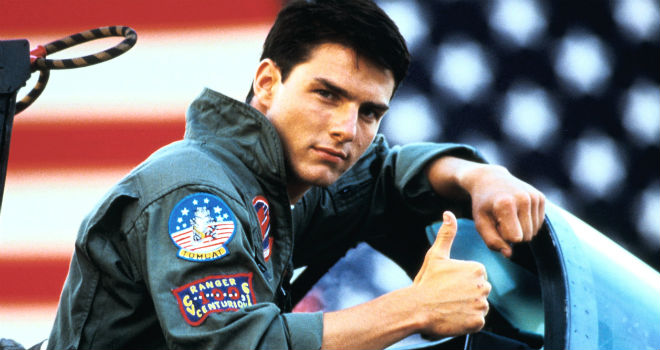 Could there be a more quintessentially 1980s movie than "Top Gun?"
Could there be a more quintessentially 1980s movie than "Top Gun?"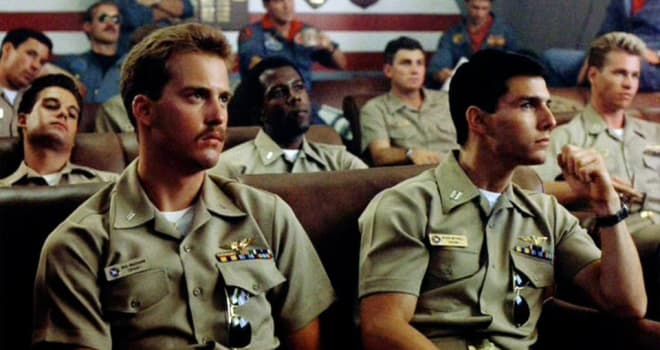 1. The film originated as "Top Guns," a 1983 article by Ehud Yonay in California Magazine. It profiled the Navy pilot training center at Miramar, in San Diego, and featured aerial photography by a Top Gun pilot. Co-screenwriter Jack Epps Jr. researched the script by attending Top Gun classes and getting flown around in an F-14.
1. The film originated as "Top Guns," a 1983 article by Ehud Yonay in California Magazine. It profiled the Navy pilot training center at Miramar, in San Diego, and featured aerial photography by a Top Gun pilot. Co-screenwriter Jack Epps Jr. researched the script by attending Top Gun classes and getting flown around in an F-14.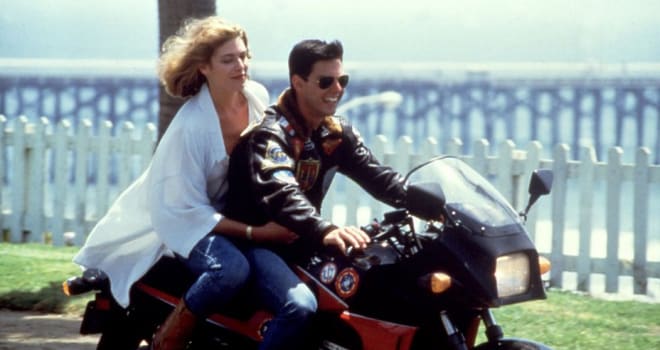 4. Kelly McGillis initially turned down the love-interest role, since the character was written as an aerobics instructor. Then the filmmakers met Christine "Legs" Fox, a civilian tactician at Miramar who earned her Top Gun nickname because of her 6'0" height. She became the inspiration for Charlie Blackwood, the instructor role that McGillis ultimately accepted. Fox would go on to become the highest ranking woman at the Pentagon before she retired in 2014.
4. Kelly McGillis initially turned down the love-interest role, since the character was written as an aerobics instructor. Then the filmmakers met Christine "Legs" Fox, a civilian tactician at Miramar who earned her Top Gun nickname because of her 6'0" height. She became the inspiration for Charlie Blackwood, the instructor role that McGillis ultimately accepted. Fox would go on to become the highest ranking woman at the Pentagon before she retired in 2014.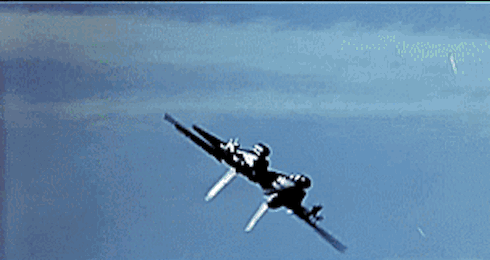 7. The F-14 planes and other naval aircraft -- along with their fuel, their pilots, and support staff -- cost the production $7,800 per hour in rental fees. Even more expensive was the aircraft carrier. During one sequence, the carrier captain had to change course, altering the angle of light for the shot. Told it would cost $25,000 to turn the ship around, director Tony Scott dashed off a check for that amount and got the captain to reverse course in order to get five more minutes of light to finish the sequence.
7. The F-14 planes and other naval aircraft -- along with their fuel, their pilots, and support staff -- cost the production $7,800 per hour in rental fees. Even more expensive was the aircraft carrier. During one sequence, the carrier captain had to change course, altering the angle of light for the shot. Told it would cost $25,000 to turn the ship around, director Tony Scott dashed off a check for that amount and got the captain to reverse course in order to get five more minutes of light to finish the sequence.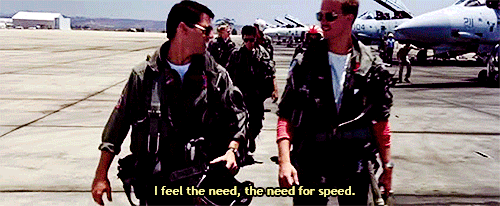 10. "Top Gun" also became an early top-seller in the then-new videocassette market, as it was one of the first films priced to sell (at just $20), not just to rent.
10. "Top Gun" also became an early top-seller in the then-new videocassette market, as it was one of the first films priced to sell (at just $20), not just to rent.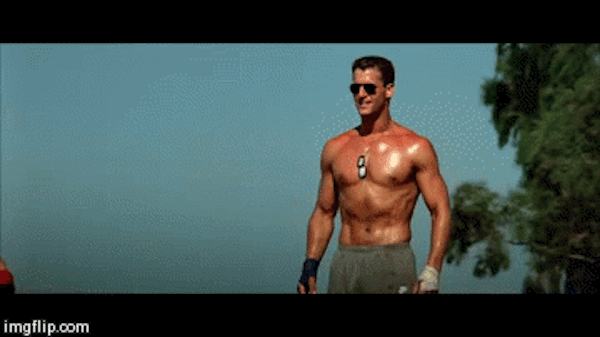 13. Did all that male bonding, towel-snapping, and shirtless volleyball-playing make "Top Gun" a covertly homoerotic movie? Many critics (and comedians) have thought so. Most famously, Quentin Tarantino delivered a hilarious (and NSFW) monologue on the topic in the 1994 movie "Sleep With Me."
13. Did all that male bonding, towel-snapping, and shirtless volleyball-playing make "Top Gun" a covertly homoerotic movie? Many critics (and comedians) have thought so. Most famously, Quentin Tarantino delivered a hilarious (and NSFW) monologue on the topic in the 1994 movie "Sleep With Me."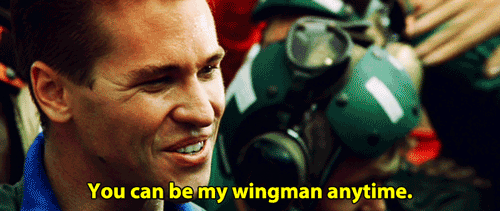
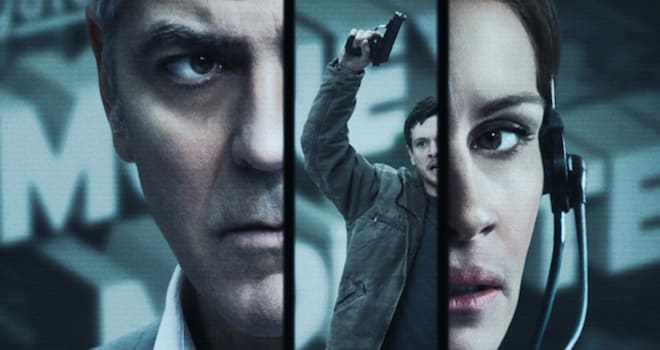 15 years ago, a movie starring
15 years ago, a movie starring  There was similar discussion this time last year, when Clooney's "
There was similar discussion this time last year, when Clooney's "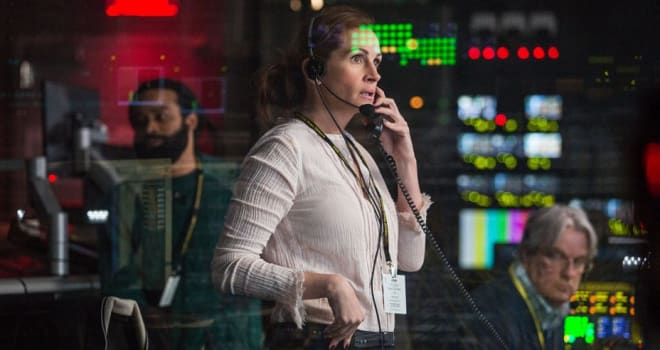 Roberts, too, is considered a waning star, but she has two films right now in the top five. "
Roberts, too, is considered a waning star, but she has two films right now in the top five. "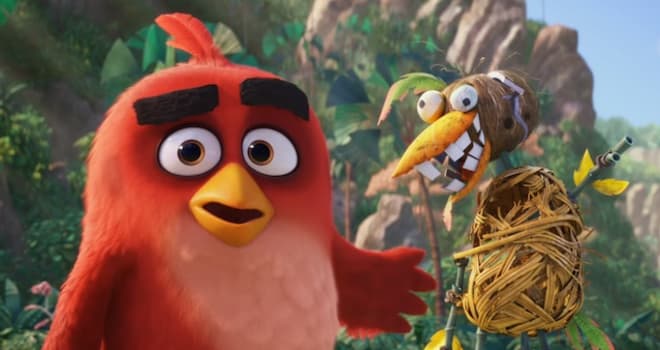 So much for the three-peat.
So much for the three-peat.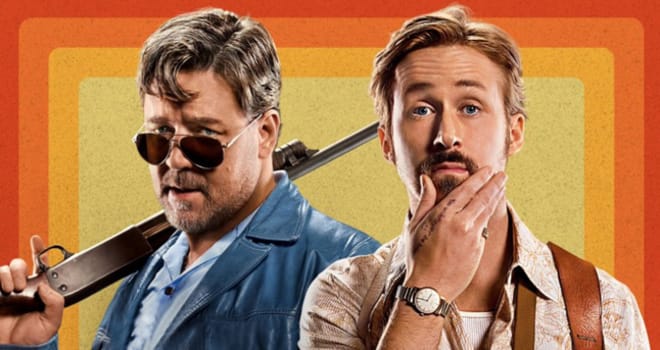 Nonetheless, "
Nonetheless, "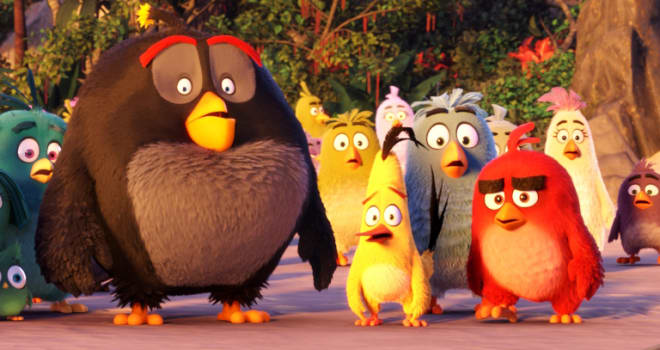 1. The "Birds" Empire Is Bigger Than You Thought
1. The "Birds" Empire Is Bigger Than You Thought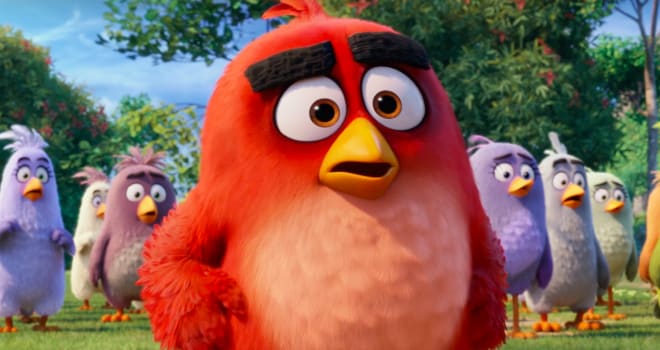 3. Fans Liked the Execution
3. Fans Liked the Execution 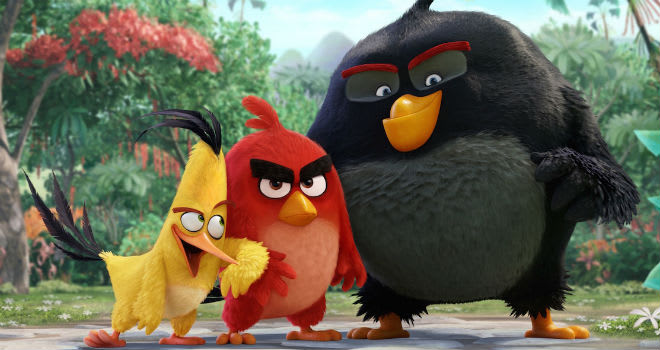 5. Timing
5. Timing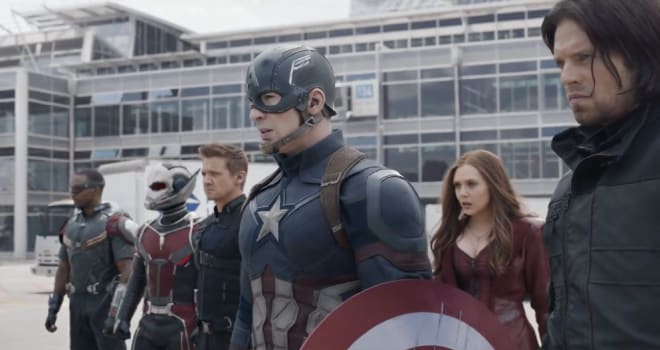 Meanwhile, Rovio spent so much marketing "The Angry Birds Movie" that it had to lay off 40 percent of its staff last summer. And despite the film's global take so far of $151 million, "Angry Birds" is going to have to gross about $360 million worldwide just to break even (since about half that take will go to the theater owners). It may reach that mark, and a sequel is probably inevitable, but if Rovio is really going to turn this weekend's chart-topping debut into a viable franchise, it's going to have to knock down an awfully tall pig pile.
Meanwhile, Rovio spent so much marketing "The Angry Birds Movie" that it had to lay off 40 percent of its staff last summer. And despite the film's global take so far of $151 million, "Angry Birds" is going to have to gross about $360 million worldwide just to break even (since about half that take will go to the theater owners). It may reach that mark, and a sequel is probably inevitable, but if Rovio is really going to turn this weekend's chart-topping debut into a viable franchise, it's going to have to knock down an awfully tall pig pile. Before 1996, "Mission: Impossible" was a long-since-cancelled TV spy series, beloved by Boomers but forgotten by anyone younger. Today, of course, it's a popular Tom Cruise movie franchise, known for its twisty plotting and jaw-dropping stunt sequences, whose five installments to date have grossed $935 million in North America and $2.8 billion worldwide.
Before 1996, "Mission: Impossible" was a long-since-cancelled TV spy series, beloved by Boomers but forgotten by anyone younger. Today, of course, it's a popular Tom Cruise movie franchise, known for its twisty plotting and jaw-dropping stunt sequences, whose five installments to date have grossed $935 million in North America and $2.8 billion worldwide.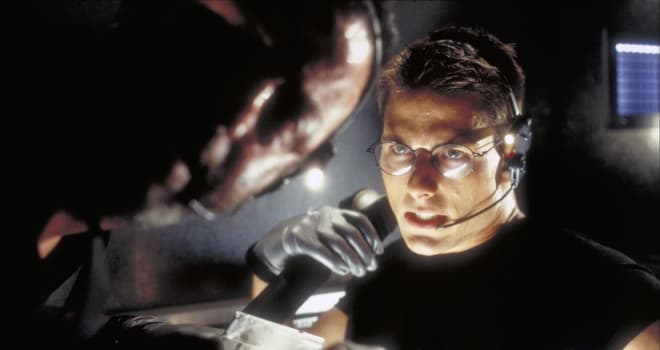 1. "Mission: Impossible" marked Cruise's debut as a producer. In a deal that would become his then-customary contract, he took no money up front but negotiated a lucrative percentage of the theatrical and video gross profits, reportedly as high as 22 percent. Cruise reportedly pocketed an estimated $70 million for the first "Mission."
1. "Mission: Impossible" marked Cruise's debut as a producer. In a deal that would become his then-customary contract, he took no money up front but negotiated a lucrative percentage of the theatrical and video gross profits, reportedly as high as 22 percent. Cruise reportedly pocketed an estimated $70 million for the first "Mission."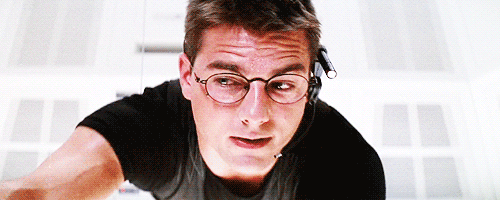 3. When Jim Phelps (
3. When Jim Phelps (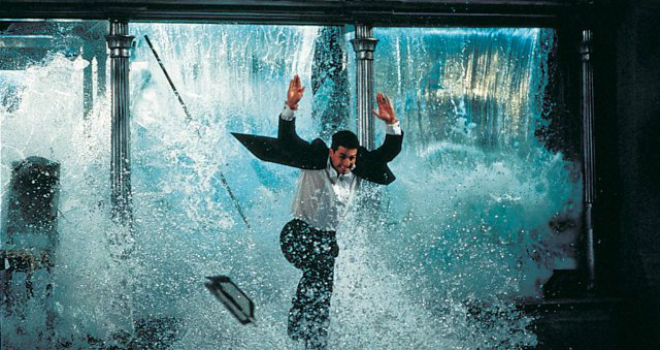 5. The exploding fish tank stunt was reportedly Cruise's idea. De Palma tried to shoot it with a stunt double, but the results were unconvincing. So that's really Cruise you see as he flees from 16 tons of rushing water.
5. The exploding fish tank stunt was reportedly Cruise's idea. De Palma tried to shoot it with a stunt double, but the results were unconvincing. So that's really Cruise you see as he flees from 16 tons of rushing water.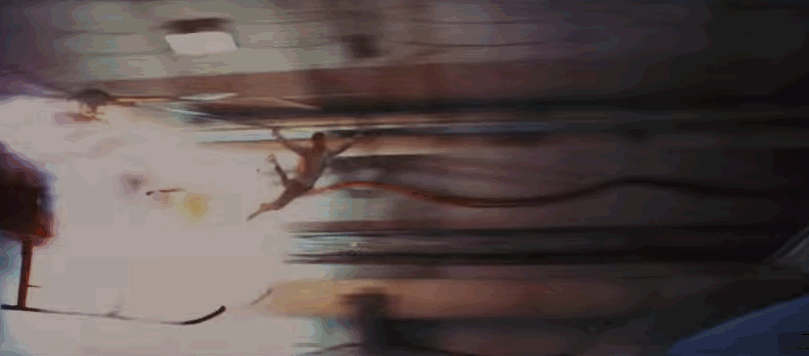 7. Even so, much of that sequence was filmed in front of a blue screen on the James Bond soundstage at Pinewood Studios. But the scene where the helicopter blast hurls Ethan onto the surface of the train (above) still involved flinging Cruise himself through the air.
7. Even so, much of that sequence was filmed in front of a blue screen on the James Bond soundstage at Pinewood Studios. But the scene where the helicopter blast hurls Ethan onto the surface of the train (above) still involved flinging Cruise himself through the air.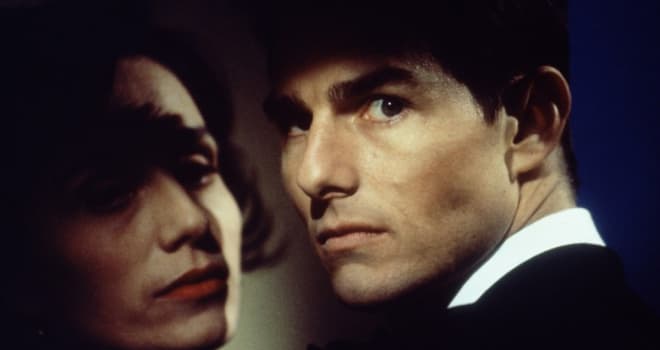 9. The opening sequence in Prague marked the first time a major Hollywood production had filmed in the Czech capital since the fall of communism. Unfortunately, Cruise and his fellow producers felt gouged by the local authorities when they rented the historic Lichetenstein Palace as an exterior location and were charged 10 times the fee they expected. City authorities claimed the lower-quoted price had never been an authorized offer.
9. The opening sequence in Prague marked the first time a major Hollywood production had filmed in the Czech capital since the fall of communism. Unfortunately, Cruise and his fellow producers felt gouged by the local authorities when they rented the historic Lichetenstein Palace as an exterior location and were charged 10 times the fee they expected. City authorities claimed the lower-quoted price had never been an authorized offer.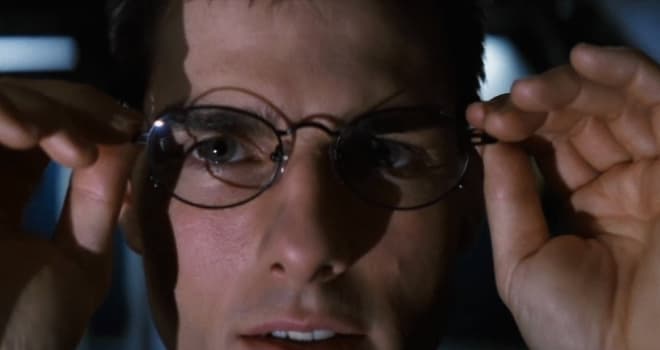 11. "Mission: Impossible" was the first film to open on more than 3,000 screens. (3,012, to be exact.) It earned $181 million in North America and $458 million worldwide.
11. "Mission: Impossible" was the first film to open on more than 3,000 screens. (3,012, to be exact.) It earned $181 million in North America and $458 million worldwide.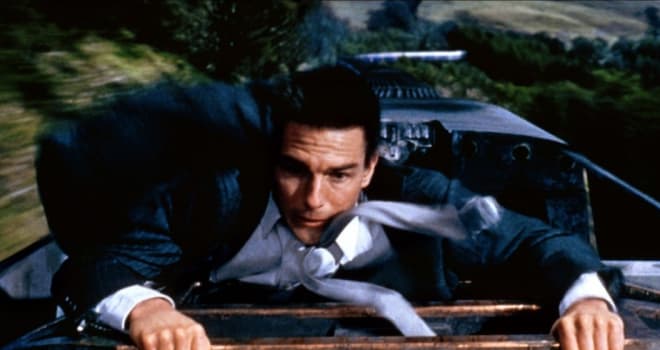 13. One original element from the show that remained intact was Lalo Schifrin's iconic, pounding theme song, which De Palma used over the opening credits. But the film closed with a new version by U2 members Adam Clayton and Larry Mullen Jr. Their pop instrumental became a top 10 hit worldwide and was nominated at the 1997 Grammys, where it competed against Schifrin's own new recording of the song.
13. One original element from the show that remained intact was Lalo Schifrin's iconic, pounding theme song, which De Palma used over the opening credits. But the film closed with a new version by U2 members Adam Clayton and Larry Mullen Jr. Their pop instrumental became a top 10 hit worldwide and was nominated at the 1997 Grammys, where it competed against Schifrin's own new recording of the song.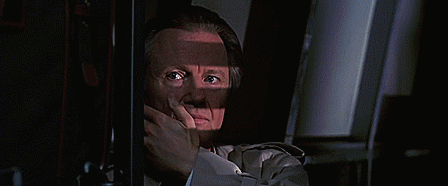 15. "Mission: Impossible" establishes Ethan for the rest of the franchise as a spy who prefers deception and disguise to violence. In this film, though not in future installments, he never gets involved in a gunfight; in fact, he never even fires a weapon. And the body count for the entire film is just seven casualties.
15. "Mission: Impossible" establishes Ethan for the rest of the franchise as a spy who prefers deception and disguise to violence. In this film, though not in future installments, he never gets involved in a gunfight; in fact, he never even fires a weapon. And the body count for the entire film is just seven casualties.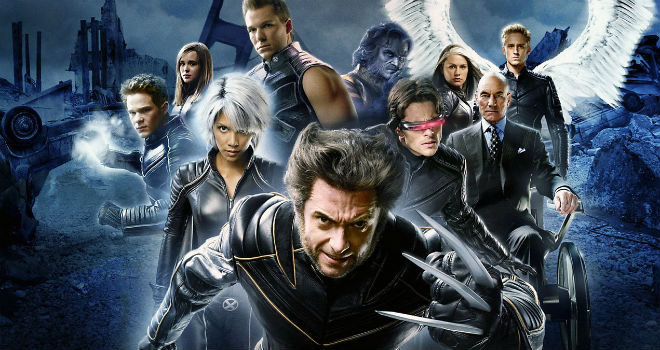 When it was released 10 years ago (on May 26, 2006), "
When it was released 10 years ago (on May 26, 2006), "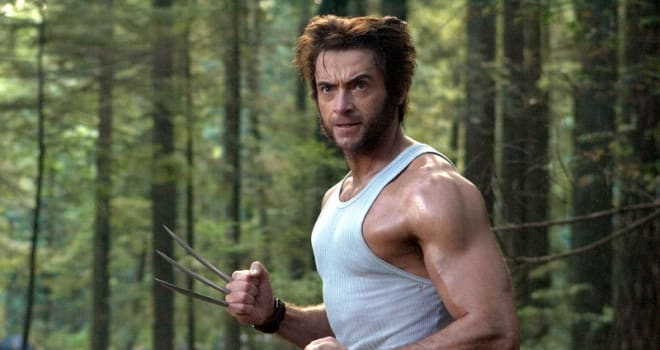 1. After directing the first two "X-Men" movies to critical and commercial success, Singer famously dropped out of the third movie to make "
1. After directing the first two "X-Men" movies to critical and commercial success, Singer famously dropped out of the third movie to make "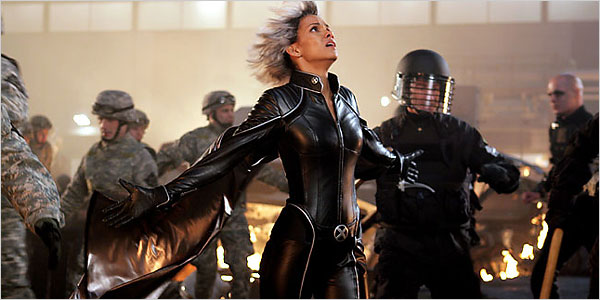 3. One star who was thrilled Ratner was on board was
3. One star who was thrilled Ratner was on board was 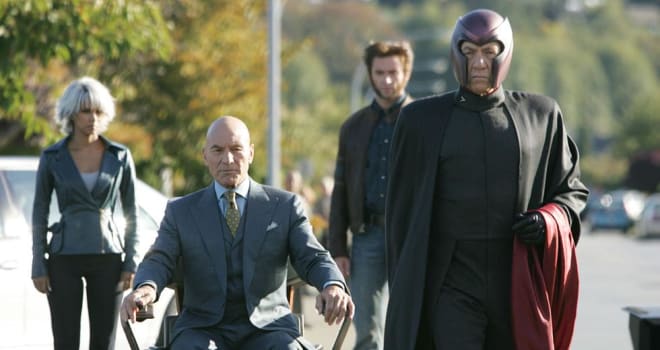 5. Like the other stars of the first two movies, Patrick Stewart wasn't contracted to do a third. But he signed on for "Last Stand" anyway, not knowing that his character, Charles Xavier, was going to be killed off.
5. Like the other stars of the first two movies, Patrick Stewart wasn't contracted to do a third. But he signed on for "Last Stand" anyway, not knowing that his character, Charles Xavier, was going to be killed off.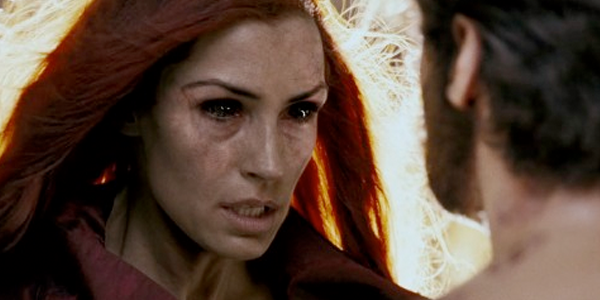 7. How much time passed between Jean Grey's death in "
7. How much time passed between Jean Grey's death in "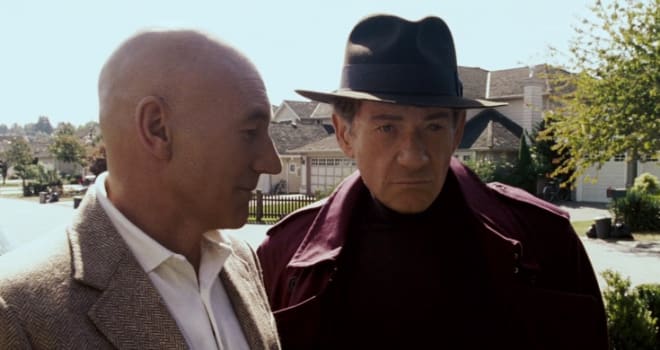 9. One of the film's most noteworthy effects, considered groundbreaking at the time, was the digital facelift used to make Stewart's Professor X and
9. One of the film's most noteworthy effects, considered groundbreaking at the time, was the digital facelift used to make Stewart's Professor X and 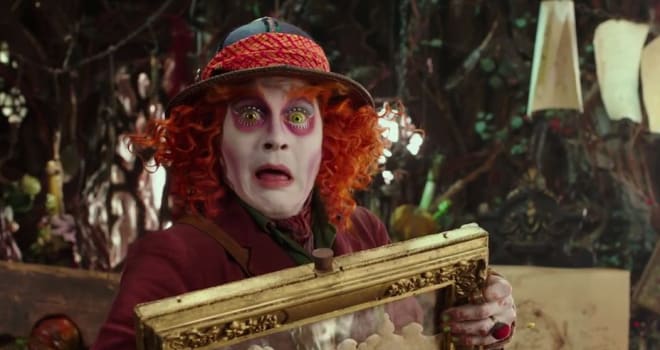 It was supposed to be a competitive race this weekend, with two blockbuster sequels grabbing large hauls of Memorial Day weekend dollars. But it wasn't even close. As the holiday revelry ends, "
It was supposed to be a competitive race this weekend, with two blockbuster sequels grabbing large hauls of Memorial Day weekend dollars. But it wasn't even close. As the holiday revelry ends, "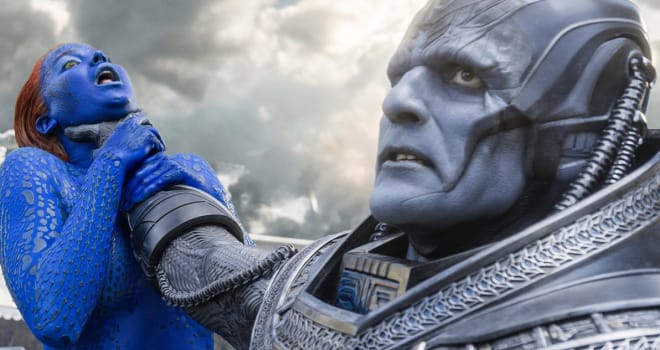 Ten years ago, "
Ten years ago, "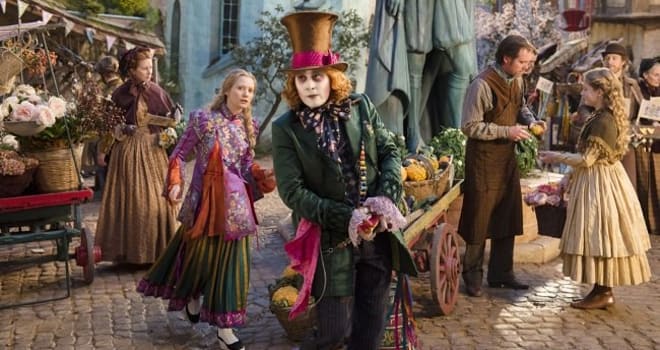 The first "Alice" came out shortly after "
The first "Alice" came out shortly after "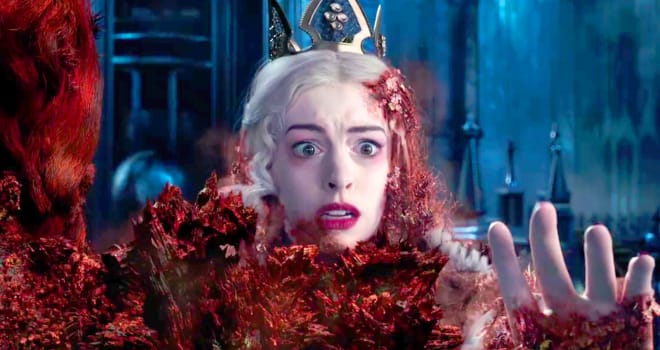 Critics weren't going to swallow from the "Drink Me" bottle again. They panned "Alice," giving it a 29 percent "Fresh" on Rotten Tomatoes and a 34 average at Metacritic. Not that kids read reviews, but their parents do. Actually, "Looking Glass" earned decent word-of-mouth from audiences, earning the same A- grade as "Apocalypse." But to generate word-of-mouth, you have to get them into the theater first.
Critics weren't going to swallow from the "Drink Me" bottle again. They panned "Alice," giving it a 29 percent "Fresh" on Rotten Tomatoes and a 34 average at Metacritic. Not that kids read reviews, but their parents do. Actually, "Looking Glass" earned decent word-of-mouth from audiences, earning the same A- grade as "Apocalypse." But to generate word-of-mouth, you have to get them into the theater first.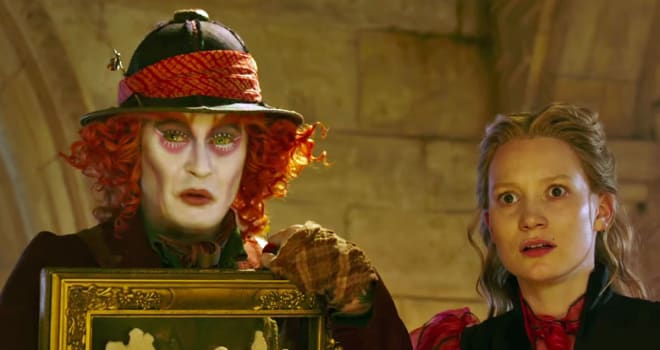 Don't feel too bad for Disney over "Alice's" stumble. The movie opened to an estimated $65.0 million overseas, where Depp remains a big star, and where viewers still like 3D. And Disney also crossed into $4 billion for the year so far -- with more than half the summer still to come.
Don't feel too bad for Disney over "Alice's" stumble. The movie opened to an estimated $65.0 million overseas, where Depp remains a big star, and where viewers still like 3D. And Disney also crossed into $4 billion for the year so far -- with more than half the summer still to come.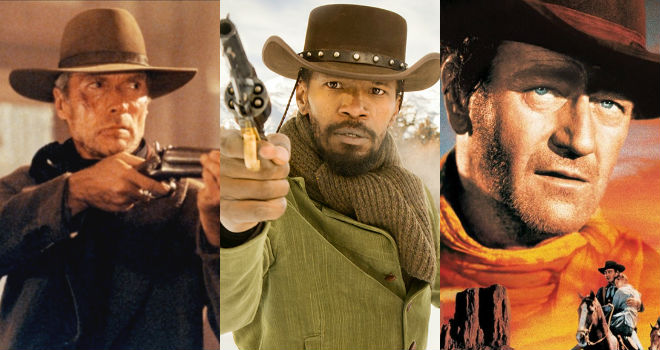 It's fitting that
It's fitting that 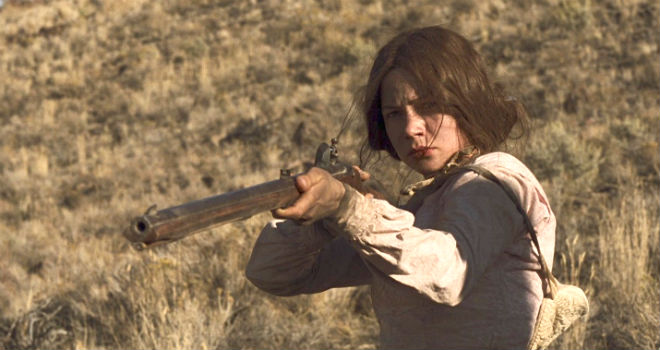 Indie filmmaker
Indie filmmaker 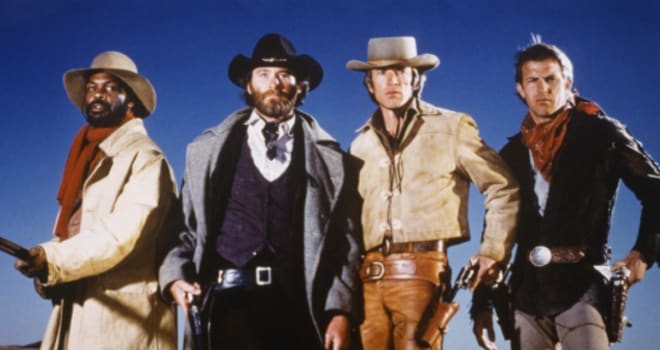 The western had been essentially dormant as a genre for a decade when
The western had been essentially dormant as a genre for a decade when 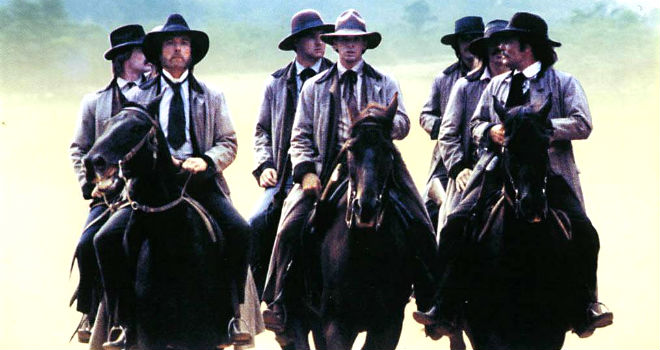 The gimmick in Walter Hill's account of the James-Younger gang is that all the characters who were brothers are played by real-life brothers. (Theres the Carradines, the Quaids, the Keaches, and the Guests.) The gimmick works surprisingly well; it makes the history among these outlaws seem a lot more personal.
The gimmick in Walter Hill's account of the James-Younger gang is that all the characters who were brothers are played by real-life brothers. (Theres the Carradines, the Quaids, the Keaches, and the Guests.) The gimmick works surprisingly well; it makes the history among these outlaws seem a lot more personal.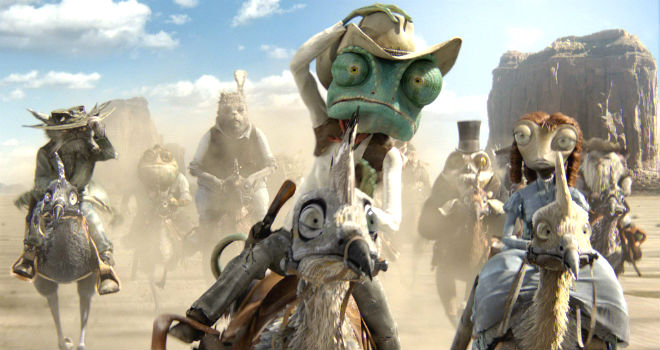 Johnny Depp stars in this clever animated western spoof. He plays a chameleon who stumbles into a dry desert town populated by anthropomorphic critters, and he's enlisted to drive off some predatory outlaws. With explicit nods to "High Noon," "Chinatown," and Clint Eastwood's spaghetti westerns, "Rango" is a film full of sly references that kids won't get but adults will appreciate.
Johnny Depp stars in this clever animated western spoof. He plays a chameleon who stumbles into a dry desert town populated by anthropomorphic critters, and he's enlisted to drive off some predatory outlaws. With explicit nods to "High Noon," "Chinatown," and Clint Eastwood's spaghetti westerns, "Rango" is a film full of sly references that kids won't get but adults will appreciate.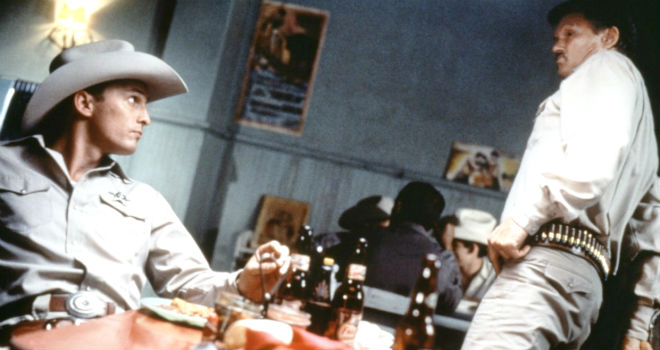 In John Sayles' modern-day western, Chris Cooper is a Texas border-town sheriff laboring under the shadow of his late, legendary lawman father (played in flashback by Matthew McConaughey). Probing a 40-year-old murder mystery that involved his father, while also rekindling a romance with an old sweetheart (Elizabeth Pena), he finds out more than he wanted to know about the truth behind his father's legend. The film is a sprawling allegory about life on the border, the way old myths continue to shape our lives, and the uneasy coexistence of many different peoples in the new West.
In John Sayles' modern-day western, Chris Cooper is a Texas border-town sheriff laboring under the shadow of his late, legendary lawman father (played in flashback by Matthew McConaughey). Probing a 40-year-old murder mystery that involved his father, while also rekindling a romance with an old sweetheart (Elizabeth Pena), he finds out more than he wanted to know about the truth behind his father's legend. The film is a sprawling allegory about life on the border, the way old myths continue to shape our lives, and the uneasy coexistence of many different peoples in the new West.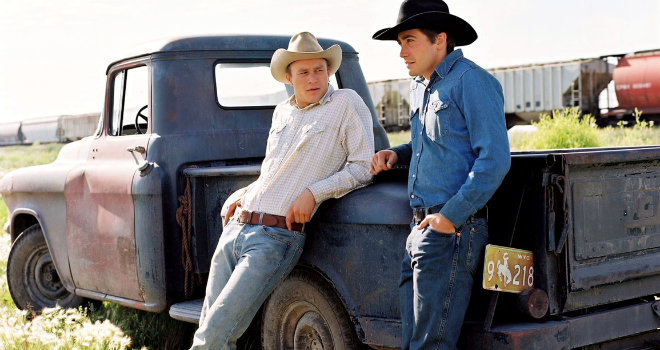 Western notions of masculinity are re-examined in Ang Lee's stately tearjerker about a ranch hand (Heath Ledger) and a rodeo rider (Jake Gyllenhaal) who fall in love. Lee's elegant direction and Ledger's laconic performance all but dare viewers to find a reason to consider these two cowboys less than manly just because of who they love.
Western notions of masculinity are re-examined in Ang Lee's stately tearjerker about a ranch hand (Heath Ledger) and a rodeo rider (Jake Gyllenhaal) who fall in love. Lee's elegant direction and Ledger's laconic performance all but dare viewers to find a reason to consider these two cowboys less than manly just because of who they love.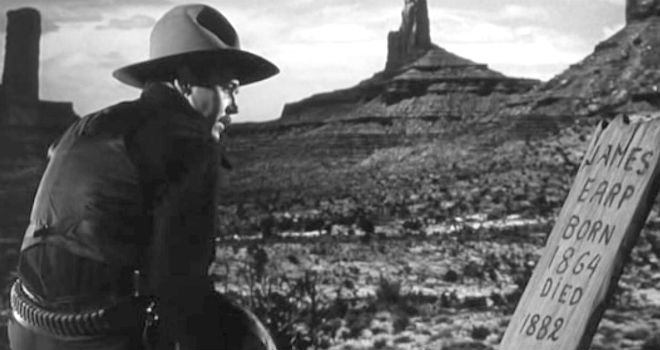 John Ford's climactic staging of the shootout at the O.K. corral is reportedly very accurate. The movie that precedes that moment is mostly hogwash, but it's well-made hogwash, with Henry Fonda playing Wyatt Earp as the reluctant gunfighter forced to strap on his holster once again, and a shockingly frail Victor Mature as a dying Doc Holliday.
John Ford's climactic staging of the shootout at the O.K. corral is reportedly very accurate. The movie that precedes that moment is mostly hogwash, but it's well-made hogwash, with Henry Fonda playing Wyatt Earp as the reluctant gunfighter forced to strap on his holster once again, and a shockingly frail Victor Mature as a dying Doc Holliday.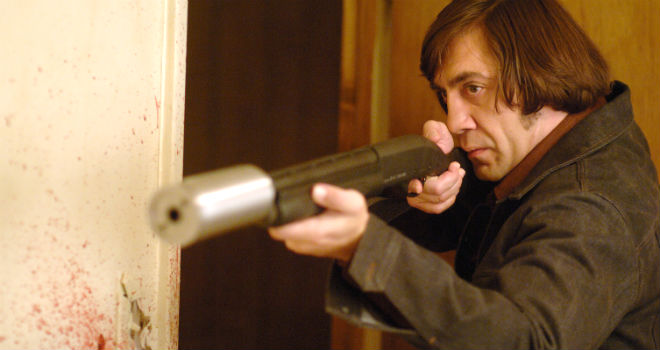 It takes place in the recent past, but the Coen brothers' Best Picture-winning adaptation of Cormac McCarthy's novel qualifies as a modern-day western. Josh Brolin is the Texan who stumbles onto a fortune, Javier Bardem (who also won an Oscar) is the implacable desperado who tracks him down, and Tommy Lee Jones is the lawman overwhelmed by evil he can't comprehend. Like many westerns, this one laments the passing of the old ways, to be replaced by a new, even more ruthless kind of savagery.
It takes place in the recent past, but the Coen brothers' Best Picture-winning adaptation of Cormac McCarthy's novel qualifies as a modern-day western. Josh Brolin is the Texan who stumbles onto a fortune, Javier Bardem (who also won an Oscar) is the implacable desperado who tracks him down, and Tommy Lee Jones is the lawman overwhelmed by evil he can't comprehend. Like many westerns, this one laments the passing of the old ways, to be replaced by a new, even more ruthless kind of savagery.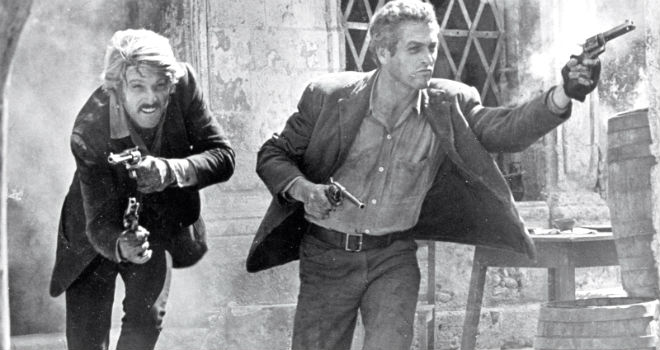 Like Sam Peckinpah's "The Wild Bunch" the same year, it's easy to see this film about outlaws who draw the wrath of the government in two different countries as a parable of the counterculture vs. the establishment But mostly, it's a fun buddy movie (and an influential one, the first of its kind), one that coasts largely on the immense charm and charisma of the Paul Newman-Robert Redford pairing.
Like Sam Peckinpah's "The Wild Bunch" the same year, it's easy to see this film about outlaws who draw the wrath of the government in two different countries as a parable of the counterculture vs. the establishment But mostly, it's a fun buddy movie (and an influential one, the first of its kind), one that coasts largely on the immense charm and charisma of the Paul Newman-Robert Redford pairing.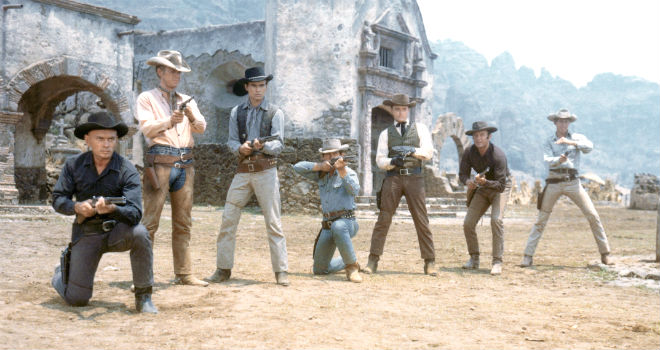
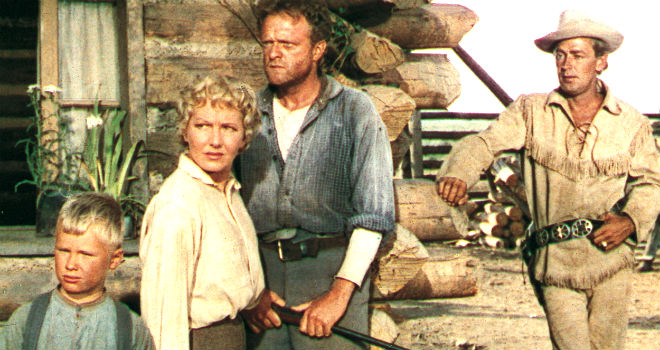 George Stevens' majestic western looks like a cliche today, but only because it launched so many of them. It's the archetypal movie about a retired gunslinger (Alan Ladd) who wants nothing more than to be a farmhand for homesteader Van Heflin, his wife (Jean Arthur), and their impressionable boy (Brandon de Wilde). But Shane is forced back into action to defend his adopted family against evil (in the form of hired gun Jack Palance). There's a lot going on here, most of it unspoken, from the history of range wars between farmers and ranchers, to Shane's unintentional displacement of Heflin in the affections of the wife and the son. It's also a gorgeously shot film, with Oscar-winning cinematography. By the time the film's over, you'll be echoing de Wilde's admiring child, begging Shane to come back.
George Stevens' majestic western looks like a cliche today, but only because it launched so many of them. It's the archetypal movie about a retired gunslinger (Alan Ladd) who wants nothing more than to be a farmhand for homesteader Van Heflin, his wife (Jean Arthur), and their impressionable boy (Brandon de Wilde). But Shane is forced back into action to defend his adopted family against evil (in the form of hired gun Jack Palance). There's a lot going on here, most of it unspoken, from the history of range wars between farmers and ranchers, to Shane's unintentional displacement of Heflin in the affections of the wife and the son. It's also a gorgeously shot film, with Oscar-winning cinematography. By the time the film's over, you'll be echoing de Wilde's admiring child, begging Shane to come back.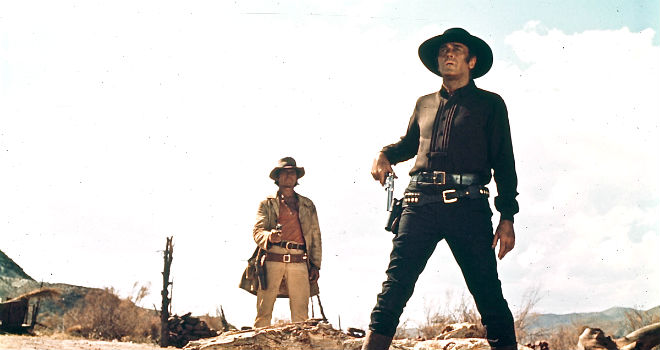 After his "Dollars" trilogy, Sergio Leone brought his spaghetti-western sensibility to Hollywood, with striking results. In this epic about a beautiful widow (Claudia Cardinale) trying to hold out against ruthless railroad barons, Henry Fonda plays against type as a cold-blooded killer, while Charles Bronson has a starmaking performance as a mysterious, harmonica-playing hero.
After his "Dollars" trilogy, Sergio Leone brought his spaghetti-western sensibility to Hollywood, with striking results. In this epic about a beautiful widow (Claudia Cardinale) trying to hold out against ruthless railroad barons, Henry Fonda plays against type as a cold-blooded killer, while Charles Bronson has a starmaking performance as a mysterious, harmonica-playing hero.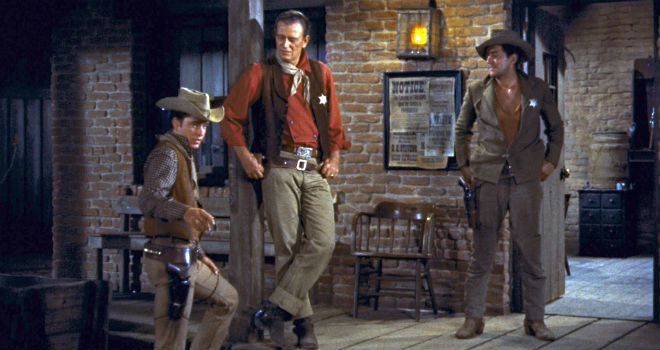 Howard Hawks and John Wayne felt that "High Noon" merited a response, a story where at least some townsfolk are brave enough come to the marshal's aid when outlaws threaten the town. But Wayne's allies here are few and unlikely -- a drunk (Dean Martin), a frail oldtimer (Walter Brennan), and a cocky kid (Ricky Nelson). As in any Hawks movie, the emphasis is as much on male bonding as it is on adventure. Dino even gets to croon a couple tunes. Still, this is as satisfying as any western ever made.
Howard Hawks and John Wayne felt that "High Noon" merited a response, a story where at least some townsfolk are brave enough come to the marshal's aid when outlaws threaten the town. But Wayne's allies here are few and unlikely -- a drunk (Dean Martin), a frail oldtimer (Walter Brennan), and a cocky kid (Ricky Nelson). As in any Hawks movie, the emphasis is as much on male bonding as it is on adventure. Dino even gets to croon a couple tunes. Still, this is as satisfying as any western ever made.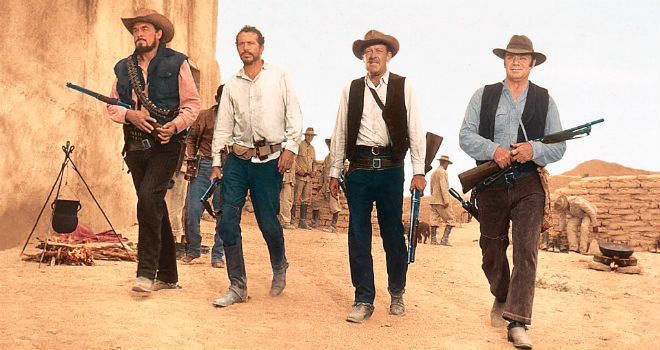 Sam Peckinpah's most notorious and influential revisionist western is this one, about a group of tough-guy aging outlaws (including William Holden, Ernest Borgnine, Warren Oates, and Ben Johnson), feeling out of place in the newly-civilized West, who head to Mexico for one last adventure. The movie's final bloodbath, choreographed like a ballet as bullets tear bodies apart in slow motion and send blood flying, is Peckinpah's signature moment as a director, his grand statement on change in the old West, and a sequence that has been the template for the presentation of movie violence for nearly half a century now.
Sam Peckinpah's most notorious and influential revisionist western is this one, about a group of tough-guy aging outlaws (including William Holden, Ernest Borgnine, Warren Oates, and Ben Johnson), feeling out of place in the newly-civilized West, who head to Mexico for one last adventure. The movie's final bloodbath, choreographed like a ballet as bullets tear bodies apart in slow motion and send blood flying, is Peckinpah's signature moment as a director, his grand statement on change in the old West, and a sequence that has been the template for the presentation of movie violence for nearly half a century now.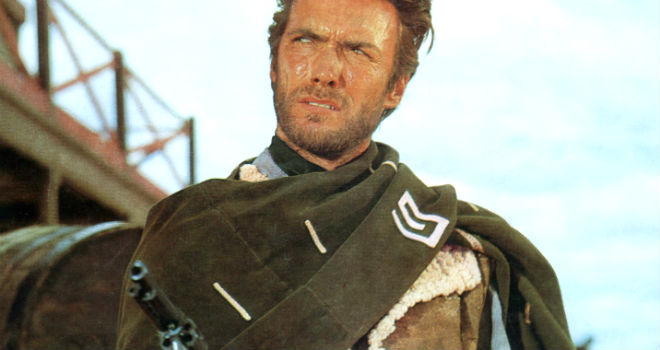 Here's the movie that changed westerns forever. It popularized the spaghetti western (so-called because it was directed by an Italian and shot in Europe, giving it an otherworldly, surreal quality that homegrown westerns lacked), demonstrated a cynicism about frontier morality that was new to the genre, and made a movie star out of TV cowpoke Clint Eastwood. The plot, in which Eastwood's gunslinger exploits the blood feud between two powerful families for his own ends, comes from Akira Kurosawa's "Yojimbo." In his first film as the iconic, poncho-clad, cigarillo-smoking Man With No Name, Eastwood has already perfected the squint and the soft-spoken delivery that will carry him through the rest of his long and celebrated career.
Here's the movie that changed westerns forever. It popularized the spaghetti western (so-called because it was directed by an Italian and shot in Europe, giving it an otherworldly, surreal quality that homegrown westerns lacked), demonstrated a cynicism about frontier morality that was new to the genre, and made a movie star out of TV cowpoke Clint Eastwood. The plot, in which Eastwood's gunslinger exploits the blood feud between two powerful families for his own ends, comes from Akira Kurosawa's "Yojimbo." In his first film as the iconic, poncho-clad, cigarillo-smoking Man With No Name, Eastwood has already perfected the squint and the soft-spoken delivery that will carry him through the rest of his long and celebrated career.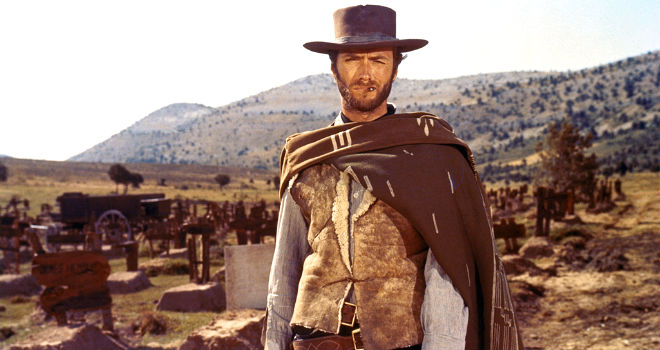 In the final movie of Sergio Leone's "Dollars" trilogy, the title refers to the characters played by Clint Eastwood, Lee Van Cleef, and Eli Wallach, respectively. But nobody in the film is all that good; Eastwood's Man With No Name may be a little more honorable than the others, but that's all. The three men compete over a stash of gold, leading to the epic three-way standoff at the film's climax. Ennio Morricone adds to the agonizingly ominous atmosphere with the most iconic instrumental score in western movie history.
In the final movie of Sergio Leone's "Dollars" trilogy, the title refers to the characters played by Clint Eastwood, Lee Van Cleef, and Eli Wallach, respectively. But nobody in the film is all that good; Eastwood's Man With No Name may be a little more honorable than the others, but that's all. The three men compete over a stash of gold, leading to the epic three-way standoff at the film's climax. Ennio Morricone adds to the agonizingly ominous atmosphere with the most iconic instrumental score in western movie history.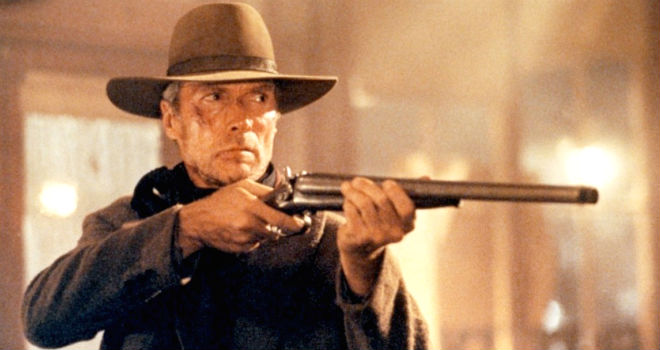 Clint Eastwood's Best Picture winner is also his farewell to the genre that made him famous. It's an unflinching look at the true costs of the violence usually valorized in westerns -- and indeed, throughout American culture. Eastwood plays a reformed outlaw, failing at supporting his family through honest work. He straps on guns again to chase a bounty on a couple of cowboys who disfigured a prostitute.
Clint Eastwood's Best Picture winner is also his farewell to the genre that made him famous. It's an unflinching look at the true costs of the violence usually valorized in westerns -- and indeed, throughout American culture. Eastwood plays a reformed outlaw, failing at supporting his family through honest work. He straps on guns again to chase a bounty on a couple of cowboys who disfigured a prostitute.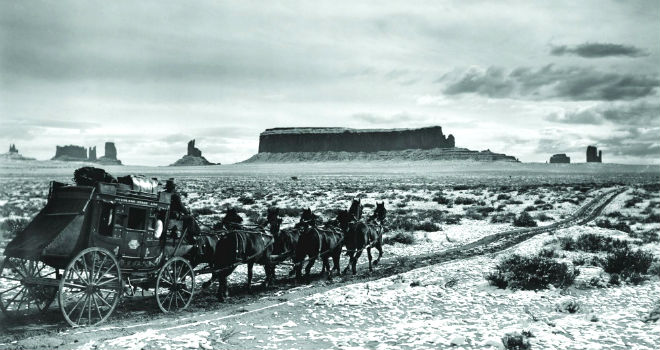 Here's the movie that made John Wayne a star and John Ford the king of all western directors. Wayne's a young gunslinger eager to prove himself, and one of several passengers from diverse walks of life on a stagecoach traveling through hostile Apache territory. Ford makes his first great use here of the majestic scenery of his beloved Monument Valley, and stuntman Yakima Canutt stages some of the most hair-raising stunt work and chase shots in film history.
Here's the movie that made John Wayne a star and John Ford the king of all western directors. Wayne's a young gunslinger eager to prove himself, and one of several passengers from diverse walks of life on a stagecoach traveling through hostile Apache territory. Ford makes his first great use here of the majestic scenery of his beloved Monument Valley, and stuntman Yakima Canutt stages some of the most hair-raising stunt work and chase shots in film history.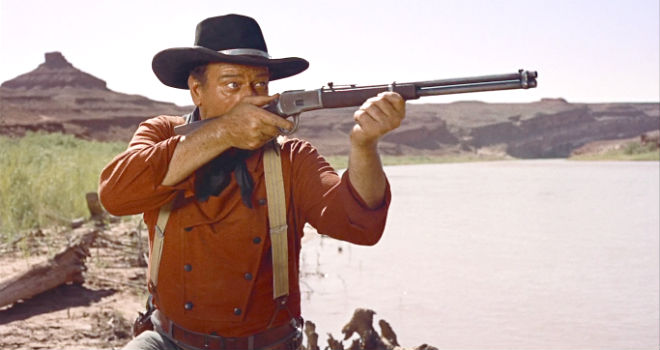 Anyone who thinks John Wayne played the same, simple, white-hatted hero in every film needs to see this movie that demonstrates not just his range as an actor but also how willing he was to make himself unlikable. As a man who spends years on an obsessive quest to find a niece (Natalie Wood) kidnapped by Comanches, he's an unredeemable racist, one who seems as apt to kill the girl for going native as to bring her safely home.
Anyone who thinks John Wayne played the same, simple, white-hatted hero in every film needs to see this movie that demonstrates not just his range as an actor but also how willing he was to make himself unlikable. As a man who spends years on an obsessive quest to find a niece (Natalie Wood) kidnapped by Comanches, he's an unredeemable racist, one who seems as apt to kill the girl for going native as to bring her safely home.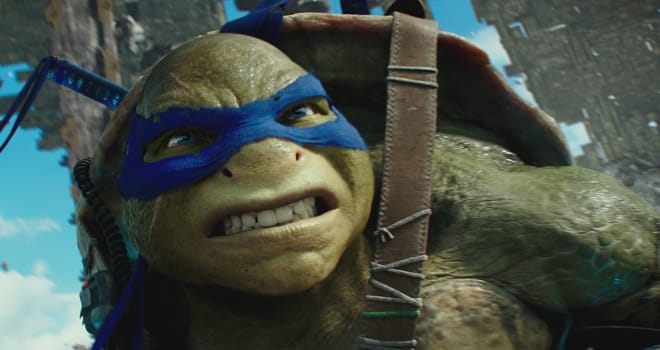 Welcome to
Welcome to 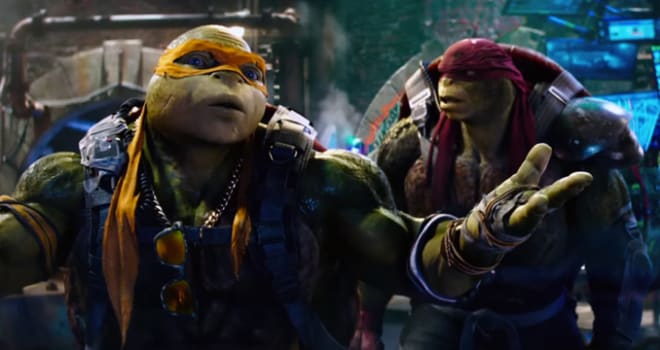 Remember, "TMNT" started out in the 1980s as a comic book parodying the "X-Men" franchise. It must be galling both to the publishers at Marvel and to the executives at Fox that their teenage mutants are playing second fiddle this weekend to the jokey, pizza-chomping, sewer-dwelling versions of their carefully cultivated intellectual property. Give credit, at least, to Paramount for recognizing that "X-Men: Apocalypse" was puny enough to be dethroned after just one week by a more kid-friendly team of comic-book heroes.
Remember, "TMNT" started out in the 1980s as a comic book parodying the "X-Men" franchise. It must be galling both to the publishers at Marvel and to the executives at Fox that their teenage mutants are playing second fiddle this weekend to the jokey, pizza-chomping, sewer-dwelling versions of their carefully cultivated intellectual property. Give credit, at least, to Paramount for recognizing that "X-Men: Apocalypse" was puny enough to be dethroned after just one week by a more kid-friendly team of comic-book heroes.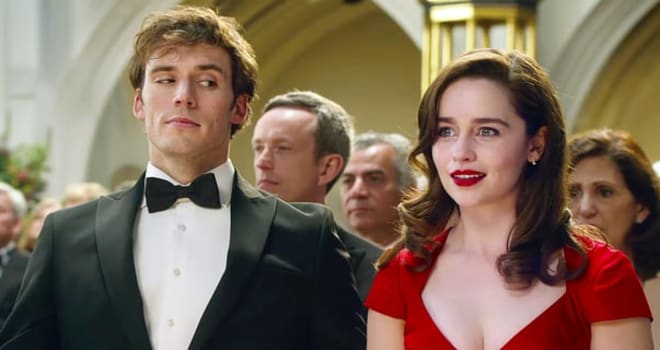 Of course, the. stars of "TMNT" are all computer-generated, but the filmmakers have chosen to surround them with actors familiar from roles in grown-ups-only movies, like
Of course, the. stars of "TMNT" are all computer-generated, but the filmmakers have chosen to surround them with actors familiar from roles in grown-ups-only movies, like 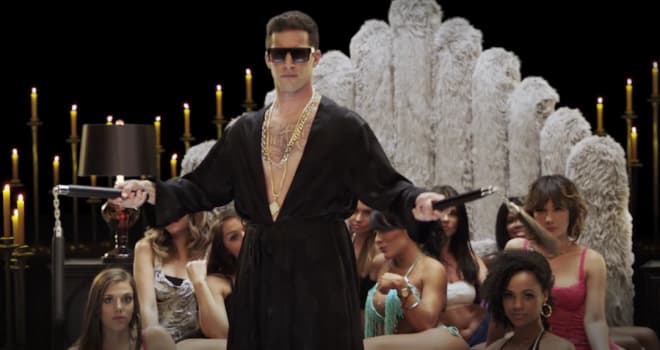 In this weekend's top 10, "Popstar" and "
In this weekend's top 10, "Popstar" and "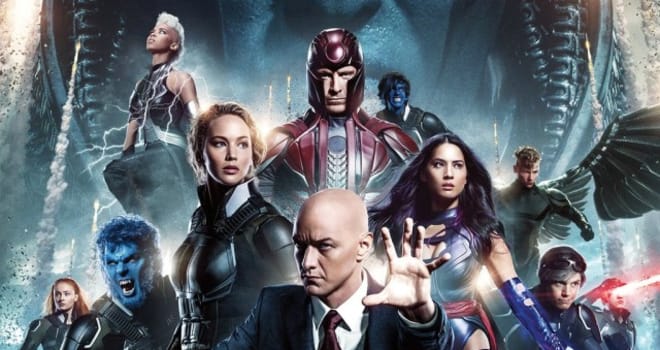 The last "Teenage Mutant Ninja Turtles," which relaunched the franchise in 2014, cost about $125 million to make and earned nearly $500 million worldwide. Given that, for blockbusters like these, marketing costs about as much as production, and that the studio keeps only about half of the worldwide ticket receipts, the 2014 "TMNT" just about broke even.
The last "Teenage Mutant Ninja Turtles," which relaunched the franchise in 2014, cost about $125 million to make and earned nearly $500 million worldwide. Given that, for blockbusters like these, marketing costs about as much as production, and that the studio keeps only about half of the worldwide ticket receipts, the 2014 "TMNT" just about broke even.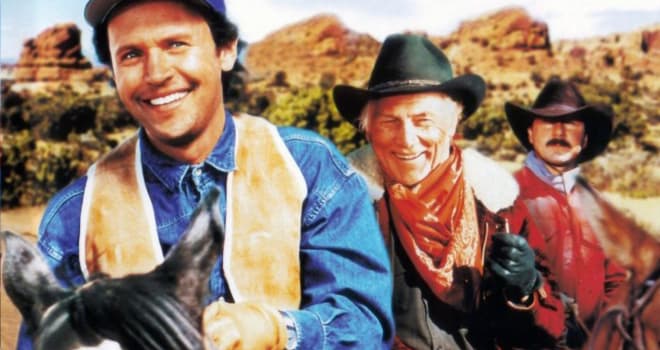 It's hard to imagine being nostalgic for a midlife crisis. Nonetheless, it's been 25 years since
It's hard to imagine being nostalgic for a midlife crisis. Nonetheless, it's been 25 years since 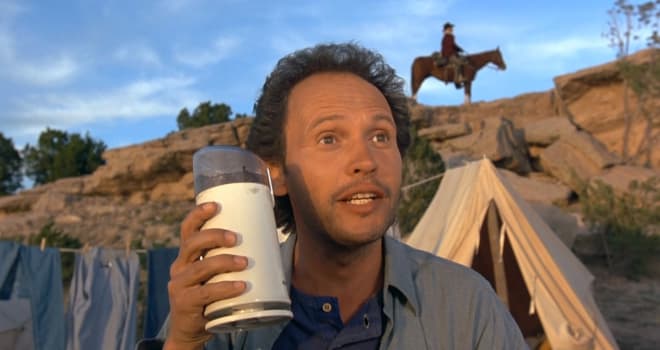 2. When Crystal was a kid, his dad ran a popular Manhattan record store and knew a lot of jazz musicians, and seven-year-old Crystal had no less than Billie Holiday for a babysitter. He sat on her lap when he went to see his first movie, the classic 1953 Western "
2. When Crystal was a kid, his dad ran a popular Manhattan record store and knew a lot of jazz musicians, and seven-year-old Crystal had no less than Billie Holiday for a babysitter. He sat on her lap when he went to see his first movie, the classic 1953 Western "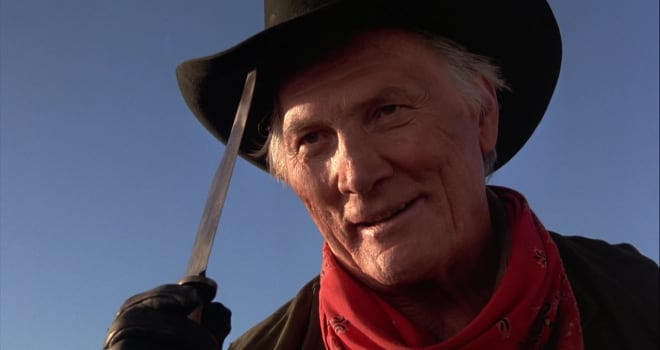 4.
4. 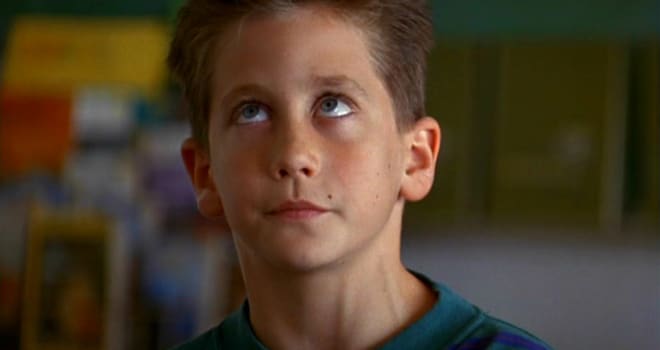 6. Crystal's softball team pal and "
6. Crystal's softball team pal and "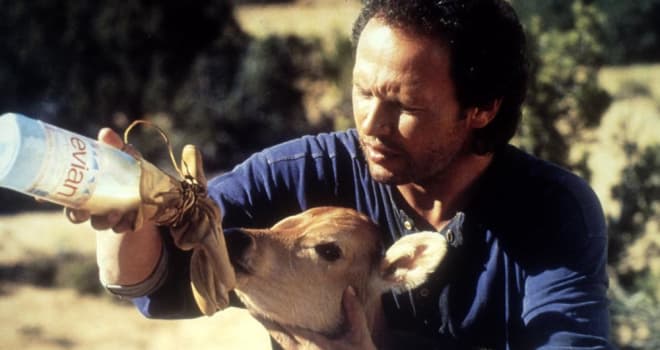 8. "City Slickers" cost a reported $27 million to make. It earned $124 million in North America and a total of $179 million worldwide.
8. "City Slickers" cost a reported $27 million to make. It earned $124 million in North America and a total of $179 million worldwide.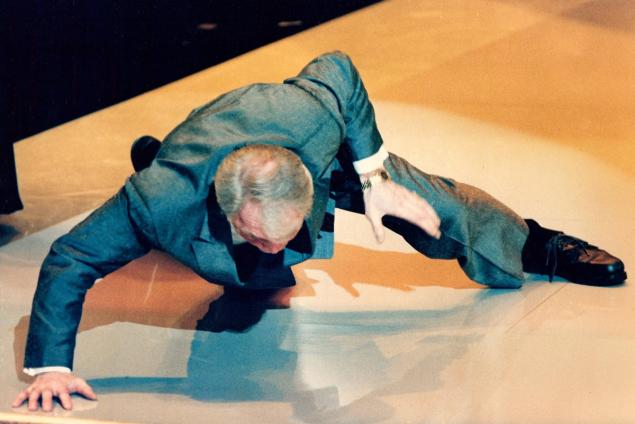 10. When his "City Slickers" performance won the Oscar for Best Supporting Actor -- 38 years after his previous nomination, for "Shane" -- Palance famously wowed the Academy Awards audience and host Crystal with a celebratory round of one-armed push-ups. Turns out the 73-year-old was re-enacting the display he'd given to the film's insurers to prove he was fit enough to play Curly.
10. When his "City Slickers" performance won the Oscar for Best Supporting Actor -- 38 years after his previous nomination, for "Shane" -- Palance famously wowed the Academy Awards audience and host Crystal with a celebratory round of one-armed push-ups. Turns out the 73-year-old was re-enacting the display he'd given to the film's insurers to prove he was fit enough to play Curly.